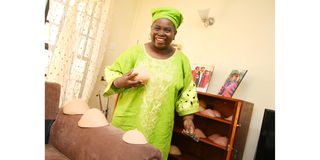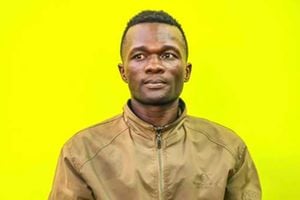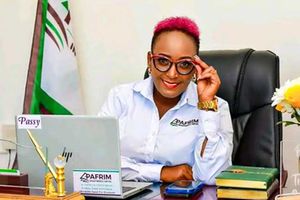Losing a breast birthed my silicon breasts enterprise, but the costs are prohibitive

r. Mary Mugambi is a professor of nutrition at the Technical University of Kenya (TUK). She is also the founder of Anuumii, a social enterprise that makes silicone breast prothesis for women who've undergone mastectomy. Photo | Pool
What you need to know:
Dr. Mary Mugambi is a three times breast cancer survivor, who lost a breast due to the disease. The Professor of Nutrition at the Technical University of Kenya (TUK) currently makes medical-grade silicone breast prosthesis. But she decries the high costs of making the breasts because of the imported liquid prices, shipping costs, and customs duty
Before Dr. Mary Mugambi had surgery on her right breast because of cancer, she didn’t think much about her breasts. Her bosom was just another part of her body.
After the surgery in 2019, two nurses held her with their arms across her back as they led her to the bathroom. She walked past a mirror and saw a dressing pad laying on top of the wound. At that moment, her knees buckled beneath her. “Did you see that?” “I have no right breast.” She was shocked and muttered many things. Right there, she became more aware of the loss and instant feeling of being incomplete.
A few months prior to that, Mary had travelled to India to seek treatment after the breast cancer had reoccurred. Her first diagnosis was in 2016 and she was subsequently declared cancer free in 2017. A team of four doctors had given her two options—lose the breast and live or keep the breast and wait for any eventuality. She chose to have it removed.
“In 2016, my mother and I were diagnosed with breast cancer. She was in her 70s. We went through the experiences together. We attended chemotherapy sessions, teasing each other about our shaved heads as we lived one day at a time. A few months after we were declared cancer free, my mother’s recurred and she lost the fight in November 2017,” Dr Mugambi explains.
With a hearty welcome, the mother of two ushers us into her house. She’s wearing a colourful kitenge dress matching with a head wrap. “This is my living room and my workshop.” Without her telling you, it is difficult to know which of her breasts was affected.
“When I got back home from the hospital, the biggest challenge was what to do with the right side of my chest. I am a Professor of Nutrition at the Technical University of Kenya (TUK) and during that season, I was worried about meeting people. “What will they say?” Will they stare?”
She came up with a plan. She resorted to stuffing her bras with all sorts of things to create an illusion of full breasts. It could have been a pair of socks, cotton wool shaped into a ball or even a scarf. She remembers not feeling “whole” as a woman. Breast prosthetics were difficult to get, and expensive then. Her stuffing was not only uncomfortable but she was also worried that the stuffing might lead to rashes, infections, or skin abrasions.

Losing a breast birthed my silicon breasts enterprise, but the costs are prohibitive. Photo | Pool
“I started to spend many hours scouring the internet for what women wear after breast mastectomy. I knew that I didn’t want permanent implants due to health risks. That is how I chanced upon silicone breast prosthesis,” she says.
Loss of breast after mastectomy is an obvious appearance change. Many patients feel sad and depressed about the changes in their bodies after surgery. It does not make it better that society has an idealised female image which can make a woman who has lost her breast feel half of a female and their femininity challenged.
The clinical dietician started by importing silicone liquid as this was not locally available and made many mistakes. “It was a laborious task and it took me many trials to get it right. I employed techniques gathered from different sources and I was able to make silicone breast prosthesis in 2020,” she says
When it all started, the plan was not to sell but upon encouragement by her oncologist, Dr. Mugambi decided to set up a social enterprise. “My business is called Anuumii loosely abbreviated to mean “a new me.” Life without one of her breasts was new to her and she says that it resonates with many of her clients.
“Because I am fully engaged at the university during the day, I make the pads in the early hours of the night. It takes me 45 minutes to an hour to complete the first stage then give it about eight hours for curing. I make them in standard sizes for women with different breast sizes,” she offers.
The marketing strategy of the startup is through word of mouth and in the past two years, Dr. Mugambi says that she has attended to more than 70 women.
“Most of them come here wearing loose clothes to camouflage or having stuffed things inside the bras. Once they wear the pads, it is an instant change. I see smiles and lifted chins as they walk and they confess to feeling more comfortable. As survivors of breast cancer, we have gone through tough times and it is only normal to want to feel whole again. I equate cancer to someone holding a gun to your head. They can pull the trigger anytime. I am still fighting after a recurrence last year. I completed radiation in January,” says the nutritionist.
The prices for her prosthesis start at Sh7, 000 depending on the cup size. “There are women who really want these products but cannot afford them. I wish I could offer them for less but the cost of importing the liquid, the shipping cost, and customs duty are quite high. I look forward to the day that I will partner with different organisations to make these accessible to women who need them but cannot afford them,” she says.
October is Pink Month
Every October, people all over the world show their support for everyone affected by breast cancer. Dubbed, The Pink Month, the period is geared towards raising awareness of breast cancer, and educating those concerned about the disease, including early identification and signs and symptoms associated with the disease. Every year, breast cancer kills more than 500,000 women around the world. And more progress is still needed. Through research, growing knowledge about breast cancer has led to new therapies and targeted treatments that improved outcomes for many people. About 90 percent of early-stage breast cancers are curable, often with treatments that conserve the breast, and it’s important that women self-examine themselves once a month for any early signs, visit their doctor regularly, and get mammography done periodically.
While the majority of breast cancer sufferers are women, men too can be afflicted. Men do have a small amount of breast tissue which can get breast cancer. Most men who get breast cancer are over 60, although younger men can be affected too.
You are encouraged to:
- Touch your breasts: Can you feel anything unusual?
- Look for changes: Does anything feel unusual?
- Check and refer any changes to your doctor.





